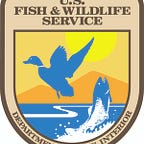Bringing Students Outdoors Virtually Takes Collaboration and Creativity
By: Julia Pinnix, visitor services manager, Leavenworth Fisheries Complex
October is the month for Kids in the Creek (KITC), a program that brings high school students to Entiat National Fish Hatchery for a day of hands-on field biology led by natural resource professionals. This year, in-person field trips were not an option, but KITC partners pulled together and made a virtual but interactive program succeed.
KITC is managed by Leavenworth Fisheries Complex and Cascadia Conservation District. Now in its 27th year, this program pulls in partners from throughout the region, from the City of Wenatchee to the US Forest Service. Chelan and Douglas county teachers rely on KITC to provide real-life science experience for their students. So when we announced that the program would not run this year, they reached out and asked for an adaptation.
But how to convert an immersive experience into something virtual yet still meaningful? The team was already at work on videos designed for interaction, due during winter. Wenatchee High School (WHS) science teachers begged for a live virtual program instead, and right now.
With less than a month to prepare, Julia Pinnix, Marjie Lodwick, and Barb Kelly from Leavenworth Fisheries Complex, Paula Salter and Kelsey Grover from the City of Wenatchee Public Works, and Jen Herdmann from Cascade Fisheries tackled the task of designing five different “virtual stations”: Macroinvertebrates, Fish Health, Habitat, Water Quality, and Riparian Zone. Everyone scrambled to pull together video footage, data, and lesson plans. The group collaborated on WHS’s Google Drive, creating worksheets with embedded videos and web links.
Over five consecutive school days, each presenter joined students live on WHS’s Zoom account. Presenters led four sessions for 50 students each time. Interactivity was built into each program. For example, the Macroinvertebrate class had students answer polls at the beginning and end to compare what they hypothesized with what their data told them. Working independently, they observed magnified videos of organisms collected in the wetland and river at Entiat NFH, used keys to identify them, and determined their tolerance levels for pollution. The presenter guided them through the process and answered questions as they came up, then led a discussion of results.
Some things could be done in a virtual setting that aren’t possible in the field. Jen took students on a tour of the Entiat River watershed, zooming over the valley in Google Earth. Barb showed underwater video footage of how salmonids use rocks and logs for cover, something hard to see even when standing in the river itself.
The experience for the students was exciting and engaging. Teachers loved the interactivity and real-life connections. There is no substitute for putting on waders and getting into a river, walking a trail in the riparian zone, handling living fish, or conducting water quality tests in person. But making connections with natural resource professionals and their work can still happen effectively online.
